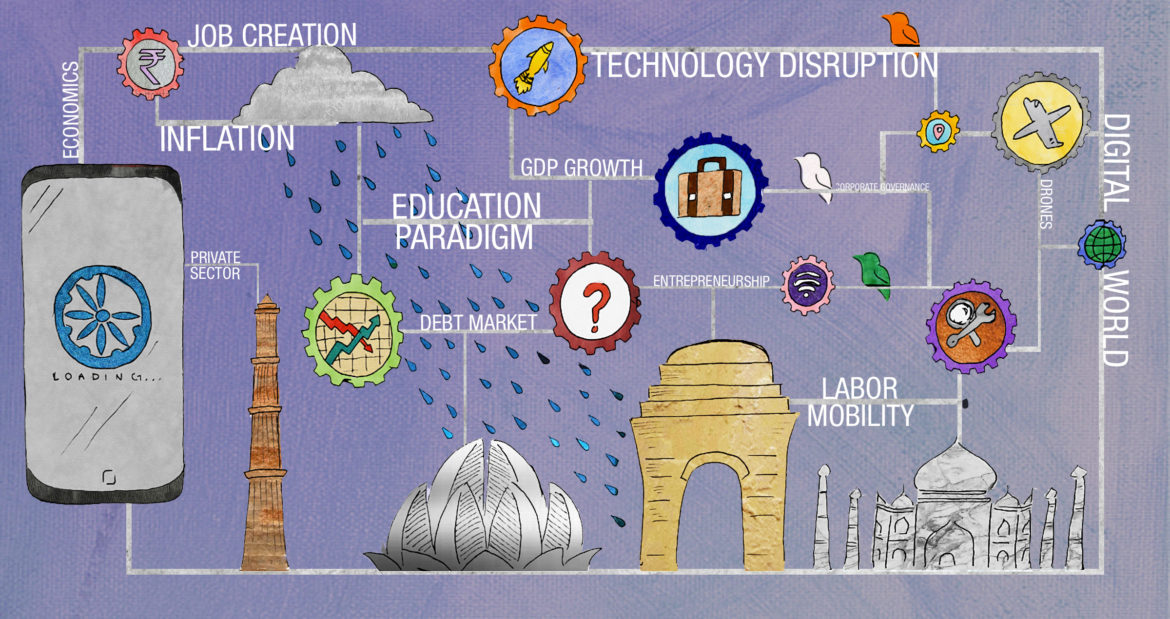When I was in IIT, some of us had been interviewed for a documentary– “I am 20”[1]– in 1967. I had then said, “Freedom in India means freedom to starve, go naked, be uneducated and die of hunger.” I was critical about the conditions in India and felt we had failed to achieve our goals. After graduation I set up an industry in plastic packaging. To me providing livelihoods was one of the key priorities, and at the end of the last century we employed 500 people.
2017
(Image Source: Link )
It is estimated that less than a hundredth of the world’s built space is designed by architects. As members of the community, this limited contribution has been the cause of some discontent to us. So, in 2013, when HSMI, the R&D cell of the Housing and Urban Development Corporation (HUDCO) accepted our proposal for a project aimed at exploring the affordable housing space, we were excited at what we saw as a precious opportunity to push the boundaries of our profession, to design for ‘the other 90 percent’ and to truly innovate.
Over the past 10 years I have been working with BIOME Environmental, an organization that looks at ways to promote sustainable living in a city – not only in theory but also in practice. The practice comes from the solutions that the group of BIOME engineers and architects offer – homes designed to keep energy requirements low, homes made of sun-dried mud blocks, homes which store and reuse rainwater, homes that treat wastewater and allow it to be reused within the site itself, etc.. I am a part of the Water team within BIOME, and this allows me the opportunity to travel and look at various aspects of water – the issues and solutions – around Bangalore and across the country. The water sources that capture my imagination and that of my team– for their beauty, human ingenuity, history, adventure and poetry – are not the springs, rivers, dams and lakes, but simple manmade structures that provide access to water – shallow open wells.
September – October, 2017
The road of life is full of important choices which lead you to where you are right now. All of us, over the course of our lives, will feel the call to deviate from the more common path. Something inside of us will be called upon to go left, when it seems that everyone else is going right. The pressure to conform, to behave and do as others do can be an overwhelming force indeed. But, this issue is about people from our own campus community who showed courage to deviate from the common path. Without their willingness to explore the road “less traveled by”, our lives may not have been quite so rich at all.
Our vision is to get children to play! As simple as that. But it took us 14 years and multiple business models to finally develop an idea that worked. The journey has not been easy. And it started in 2003. We were evaluating many start-up ideas. Nothing clicked. Until a friend shared the story of his son not playing enough and wished that there were more playgrounds. This thought sparked an idea; a business was conceived and a company named SportzVillage was formed in August 2003.
[The article below was originally an Institute lecture given by the author on August 3, 2017. Here’s the link to the video recording.]
Thank you for giving me the opportunity to deliver this prestigious Institute Lecture. I will not indulge in speculative technology forecasting but all the same, transport you into the future, because the kind of research projects or non-academic careers that you could choose may change if you knew some aspects of the future with a degree of certainty. I will demonstrate that you can even today see many of the things that will, probably, happen in a few years. You just need to identify important technological developments that have already happened and then study their impact, when adopted in specific fields, and then, study the impact of those things on things that lie further downstream. My interest in these things started one summer night in Aberdeen in 2007 when I heard on TV that a British Bank, Northern Rock had collapsed suddenly due to investments in CDS (Collateral Default Swaps), an instrument that most people had not heard of till then. I wondered how things could have been different for hapless investors, if this collapse could have been anticipated. Research led me to understand that Banks were speculating in that instrument and that it was being used by Bankers in the US to create multiple layers of pseudo assets built on poor quality loans given to people with doubtful credit history. After understanding the chain of events backwards from Northern Rock’s collapse to the root cause, I found that if one had worked forward from when reckless trading in naked CDSs had started, it would have been possible to predict the Northern Rock collapse. This thought enthused me to use the same process in the forward direction starting with the then situation, and that led me to believe that the entire global economy will collapse in the next year. I gave talks on this at various public forums from November 2007 until March 2008 by which time the fault-lines became self-evident and the collapse happened in July 2008. Then onwards, for the past decade, I have been using this very simple process of deductive logic for predicting the future after identifying things that can trigger change- social trends, politics and technology amongst many others. That is the secret behind predicting that oil price would collapse in 2008 whilst the general opinion, including that of Goldman Sachs, was that it would rise from $140 per barrel to $180.
Last month I offered an illustration of how travel rejuvenates a person, often helping one rediscover a friend’s best qualities. This month’s piece is about travelling with strangers and getting to know them better.
August – September, 2017
Our last issue helped you escape to distant lands visited by our writers, this one brings you back to reality with an exploration of current economic and sectoral trends. This month we give you plenty of food for thought on topics such as employment, energy, infrastructure, technology etc. With various experts writing about their domain, you can look forward to understanding the background to some current trends as well as being exposed to a few forecasts for the future. So throw away that crystal ball and get started on Fundamatics instead!
Dr. Romesh Wadhwani, founder of Symphony Technology Group and a philanthropist addressed the crowd of around 1000 IIT ians at a Global Business forum in Goa on October 16, 2015. His keynote, just after audacious growth targets and expectations were set by the senior members of the IIT Bombay team and the Government representatives, was grounded in a very important but neglected parameter in India’s growth story, that is employment!









